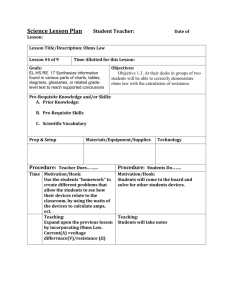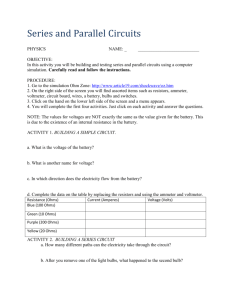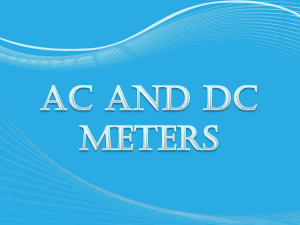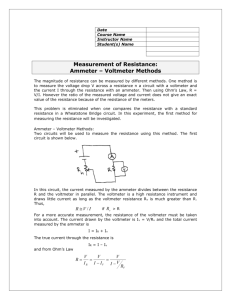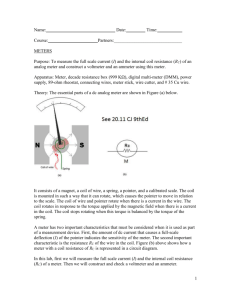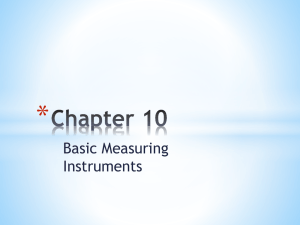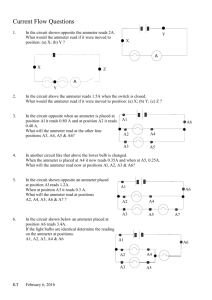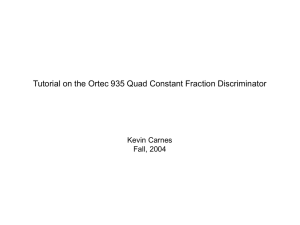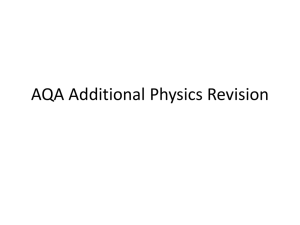Lecture 5
advertisement
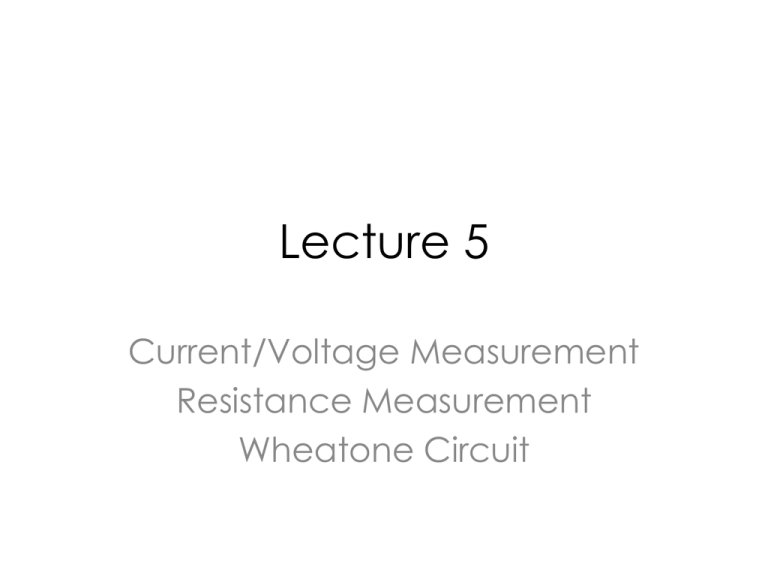
Lecture 5 Current/Voltage Measurement Resistance Measurement Wheatone Circuit Current/Voltage Measurement Circuit Model for ideal ammeter/voltmeter An ideal ammeter has an equivalent resistance of 0 Ohm. An ideal voltmeter has an infinite equivalent resistance. d’Arsonval meter When current flows in the coil, it creates a torque on the coil, causing it to rotate and move a pointer across a calibrated scale. The deflection of the pointer is proportional to the current Commercial Rating • Rating: 50 mV and 1mA • Interpretation: When the coil is carry 1 mA, the voltage drop across the coil is 50 mV and the pointer is deflected to its full-scale position. A DC Ammeter Circuit RA is added limits the amount of current in the coil. Example 3.5 (a) • A 50 mV, 1 mA d’Arsoval movement is to be used in an ammeter with a fullscale reading of 10 mA. Determine RA. (10 mA) (1 mA, 50 mV) Current through RA? Example 3.5 (c) • How much resistance is added to the circuit when the 10 mA ammeter is inserted to measure current? (10 mA) Rm (1 mA, 50 mV) 50 mV/1mA=50 Ohms 50 Ohms in parallel with RA (which is 50/9 Ohms) gives 5 Ohm. Example 3.5 (b) • A 50 mV, 1 mA d’Arsoval movement is to be used in an ammeter with a fullscale reading of 1 A. Determine RA. (1 A) (1 mA, 50 mV) Current through RA? Example 3.5 (b) • How much resistance is added to the circuit when the 1 A ammeter is inserted to measure current? (1 A) (1 mA, 50 mV) Rm 50 mV/1mA=50 Ohms 50 Ohms in parallel with RA (which is 50/999 Ohms) gives 50 mOhm. A DC Voltmeter Circuit RV is added limits the voltage drop across the meter’s coil. Example 3.6 • A 50 mV, 1 mA d’Arsoval movement is to be used in a voltmeter in which the full-scale reading is 150 V. Determine RV. + + (150 V) - 1 mA - 50 mV Needle resistance: 50 mV/1mA=50 Ohms Example 3.6 (c) • How much resistance does the 150 V meter insert into the circuit? + + (150 V) Rm - 1 mA - 50 mV Rv=149,950 Ohms, Rm=Rv+50mV/1mA=150,000 KOhms Accuracy of Multimeter • Analog multimeters: 3% • Portable Digital Multimeter: 0.5 % • Wheatstone: 0.1 % Resistance Measurement Wheastone Bridge Used to measure Resistance between 1 Ohms and 1 MOhms R1,R2, and R3 are known resistors Rx is the unknown resistor Adjust R3 until there is no current in the meter Determine Rx • Adjust the variable resistor R3 until there is no current in the galvanometer. • Calculate the unknown resistor from the simple expression: – Rx=(R2/R1)R3 Derivation No current from a to b i1=i3 I2=ix Relationship: VR1=VR2 VR3=VRx Possible Range of Rx • Rx=(R2/R1)R3 – Change R2/R1 in order to measure a wide range of Rx – Implement R2 and R1 using precision R1, R2 that can be switched into the bridge circuit. Possible values: 1,10, 100, 1000 Ohms – Range of R2/R1: 0.001 to 1000 – Range of R3 usually from 1 to 10 Kohms – Measurable Rx is from1 Ohm to 1 MOhm Meter Resistance Included What do you do with this resistive network? Can you simplify it? Δ to Y Equivalent Circuit

